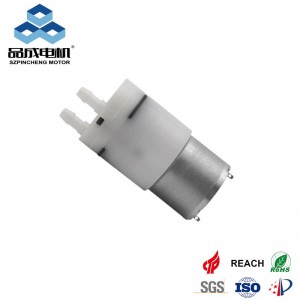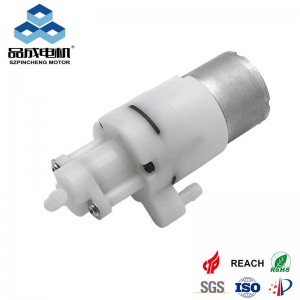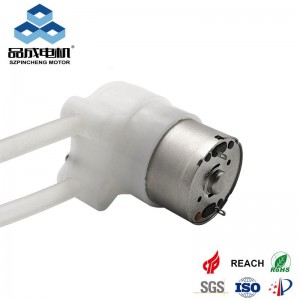With its small size, oil-free and strong self-priming ability, the micro diaphragm pump plays a key role in the fields of medical equipment, laboratory instruments, environmental monitoring, small water treatment, etc. However, just like a precision watch is afraid of severe vibration, the micro diaphragm pump also has two "natural enemies": overload operation and dry operation (idling). They are like invisible killers, which will quietly accelerate the damage of the pump and shorten its service life.
1. Overload operation: The motor is "overloaded"
Imagine what would happen if you were asked to walk with a load that was far beyond your ability to bear? The same principle applies to motor overload.
Current soars and heat increases dramatically: When the outlet pressure of the pump rises abnormally (such as the outlet valve is accidentally closed or the pipeline is severely blocked) or the viscosity of the driven medium is too high, the motor needs to output a torque far exceeding the design value to maintain operation. This will cause the motor coil current to increase sharply.
High temperature burning, insulation failure: The most direct consequence of the increase in current is a surge in the internal temperature of the motor. Excessive temperature will:
Damage the coil insulation paint: The insulation layer ages, becomes brittle or even carbonized, which may eventually cause the coil to short-circuit and burn.
Damage permanent magnets (if any): High temperature will weaken the magnetism of permanent magnets, reduce motor efficiency or even fail.
Accelerate bearing aging: High temperature lubricant fails, bearings dry grind, and wear increases.
The protection mechanism is key: Reliable quality micro diaphragm pumps usually have built-in thermal protectors (such as thermal fuses or self-resetting thermal protectors). When the overload causes the temperature to reach a dangerous threshold, the protector cuts off the power supply, which is the last line of defense to prevent the motor from burning out. However, if the protector fails or the pump itself has no protection device, overload will directly cause the motor to be scrapped.
2. Dry running (idling): "fatal thirst" due to lack of water
If overloading is "death from exhaustion", dry running is more like "death from thirst" and "death from heat".
Cooling failure, heat accumulation: The moving parts inside the dc diaphragm pump (such as connecting rods, bearings, diaphragms, valve plates) will generate friction heat during operation. During normal operation, the fluid being transported (especially water-based liquids) will flow through the pump cavity, taking away this heat, playing a key cooling and lubrication role. When the pump is running without liquid (inlet blocked, no liquid at the suction end, medium drained), this cooling and lubrication effect completely disappears.
Friction increases, wear soars: Without liquid lubrication, metal parts (such as connecting rods, bearings) or engineering plastic parts (such as valve balls/seats, diaphragm and pump head contact surfaces) that originally slide on the fluid film will fall into a serious dry friction state, resulting in:
Abnormal wear: Rapid wear, scratches, and deformation of parts surface.
Uncontrolled temperature rise: The heat generated by friction cannot be dissipated, and the local temperature rises sharply.
Friction increases, wear soars: Without liquid lubrication, metal parts (such as connecting rods, bearings) or engineering plastic parts (such as valve balls/seats, diaphragm and pump head contact surfaces) that originally slide on the fluid film will fall into a serious dry friction state, resulting in:
Abnormal wear: Rapid wear, scratches, and deformation of parts surface.
Uncontrolled temperature rise: The heat generated by friction cannot be dissipated, and the local temperature rises sharply.
Disasters of diaphragms and valves: Dry running has a particularly fatal impact on diaphragms and valves:
Aging and rupture of diaphragms: Engineering rubber or plastic diaphragms will age, harden, lose elasticity, and eventually fatigue crack or tear under high temperature and lack of medium lubrication/cooling.
Failure of valve seals: Valve balls/seats are easily worn and deformed under dry friction and high temperature, losing their sealing properties, resulting in a significant decrease in the pump's suction and discharge capacity or even complete failure.
Cavitation effect (cavitation) damage: Under high-speed dry running, the rapidly moving diaphragm in the pump cavity may produce local low-pressure bubbles and high-pressure shocks similar to cavitation, further exacerbating internal damage.
More vigilance for silent pumps: Some diaphragm pumps with silent designs may rely on the fluid in the pump cavity to assist in heat dissipation. When running dry, the heat dissipation conditions deteriorate more seriously, posing a greater threat to the motor.
3. How to protect your precious micro diaphragm pump?
Prevention is better than repair. Avoiding overload and dry running is the key to extending the life of the pump:
Prevent inlet blockage or interruption: Ensure that the suction pipeline is unobstructed and there is enough medium at the source. In situations where it is easy to dry out, consider installing a liquid level sensor to control the start and stop of the pump.
Avoid outlet overpressure: Do not close the outlet valve at will or block the outlet when the pump is running. When designing the system, ensure that the outlet pressure is within the rated range of the pump. Using a pressure relief valve is an effective means to prevent accidental overpressure.
Pay attention to the characteristics of the medium: When conveying high-viscosity liquids or easily crystallized media, pay special attention to the possible increase in resistance or blockage risks.
Choose a pump with protection: Give priority to pumps with built-in overheat protectors, which is the last safety guarantee.
Regular maintenance and monitoring: Pay attention to the sound of the pump running (dry running or overload is often accompanied by abnormal noise), touch the temperature of the pump body (abnormal heating is an important warning signal), and regularly check the status of vulnerable parts such as diaphragms and valves.
Conclusion:
Even the micro diaphragm pump is small, the damage caused by overload and dry running is huge and often irreversible. Motor burnout, diaphragm rupture, valve failure, bearing wear... These failures not only mean expensive downtime and replacement costs, but are also likely to affect the normal operation of your entire equipment. Understanding the causes and hazards of these two dangerous conditions and taking active preventive measures is the only way to ensure that your micro diaphragm pump works stably for a long time. Treat your pump well, and it will give you more reliable service in return.
Simply put: let the pump "work" at the right pressure (avoid overload), and give it "full" of liquid before working (strictly prevent dry running), so that it can serve you healthily and long-lived!
Welcome to contact Pincheng Motor, our factory offer the high quality dc diaphragm pump. OEM and ODM service are available.
you like also all
Read More News
Post time: Jun-20-2025




